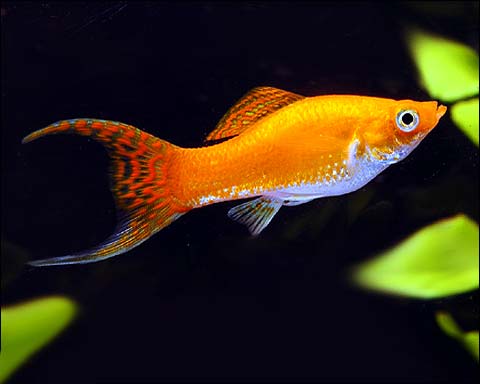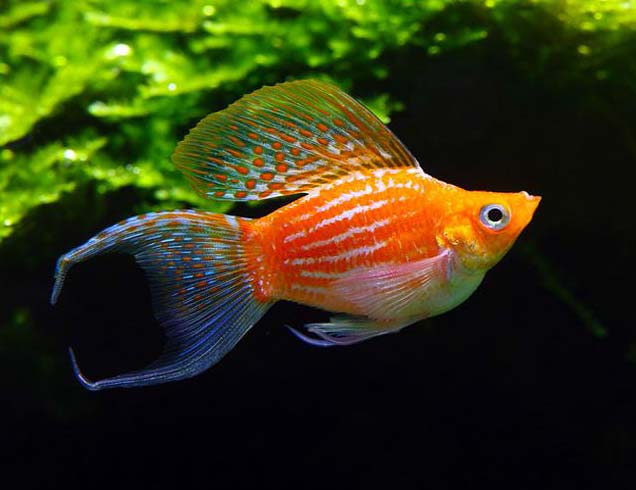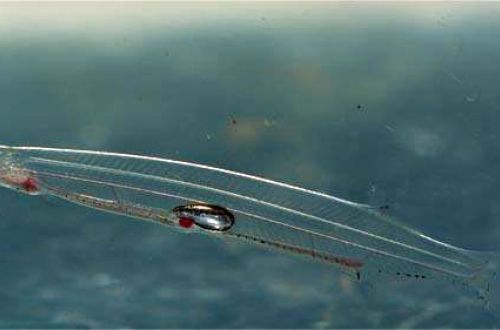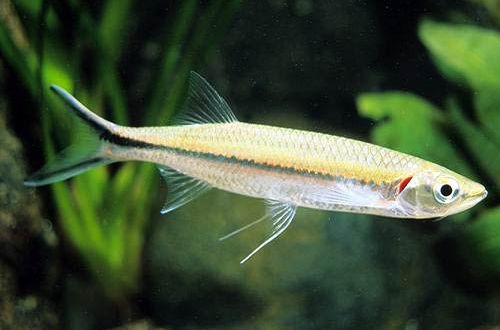
Mollies lyretail
Lyretail mollies or Molly lyre for short, the English trade name is LyreTail Molly. It is an artificially bred breed, it does not occur in the wild. Presumably, this variety was obtained as a result of selection of Mollies latipin (Poecilia latipinna).

The main distinguishing feature is the structure of the caudal fin. The extreme rays of the tail are noticeably longer than the others, forming a visual bend, reminiscent of the shape of the ancient musical instrument lyre. Coloring is the most varied. A huge number of color variations have been deduced, and none of them can be considered the main one.
In the course of hybridization with closely related species, the tail lyre also acquired varieties of Molliesia sphenops and Molliesia velifera. Therefore, by now the name of the breed has become collective and is equally used for all Mollies with a characteristic structure of the caudal fin.
Maintenance and care
Depending on the origin, the size of an adult fish can vary from 11 to 18 cm, and taking into account the elongated tail, more than 20. Thus, it is recommended to keep a group of 3–4 Lyretail mollies in an aquarium with a volume of at least 100–150 liters. In this case, the more the better. The design welcomes the presence of a large number of shelters in the form of thickets of plants and natural snags. The latter often become a place for the growth of algae, which in turn will serve as an additional source of food.

Brief information:
- The volume of the aquarium is from 100–150 liters.
- Temperature – 21-26°C
- Value pH — 7.0–8.5
- Water hardness – medium to high hardness (15-35 GH)
- Substrate type – any
- Lighting – any
- Brackish water – acceptable in a concentration of 10-15 gr. salt per liter of water
- Water movement is weak
- The size of the fish is 12–18 cm.
- Nutrition – any feed with herbal supplements
- Temperament – peaceful
- Content alone, in pairs or in a group
Food. Fish need food rich in plant ingredients. Not infrequently, to meet their needs, they damage the delicate parts of aquatic plants. A good choice would be foods designed specifically for mollies made by many well-known manufacturers. Such products are available in various forms, the most popular and easy to use dry flakes and granules.
Warm slightly alkaline water with high values of total hardness is considered the optimal environment. However, over decades of breeding and living in the artificial environment of Mollies, lyrebirds have successfully adapted to other conditions, such as low pH and GH values.

When keeping, it is important to prevent the accumulation of organic waste that can raise nitrate levels to dangerous levels. To do this, you should regularly maintain the aquarium. In particular: weekly replace part of the water with fresh water, remove uneaten food residues, excrement. An important (and perhaps decisive) importance is the uninterrupted operation of the filtration system.
behavior and compatibility. Males compete with each other for the attention of females. In small tanks with a minimum number of shelters, it is advisable to acquire a group with only one male and a few females. Compatible with most peaceful fish of comparable size. As neighbors, species that tend to pluck other people’s long fins should be avoided. Some barbs “sin” with such behavior.





